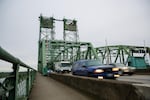Lynn Peterson and her husband built their first electric car 20 years ago. Technology has improved since then, but not that much. Today the dashboard of her Volkswagen E-Golf says we have 80 miles left.
We’ll need each one.

Courtesy of Lynn Peterson for Metro President
As she
as president of Metro, the Portland area’s regional government, Peterson is focused on all the places in between the long, car-centric stretches of asphalt that connect the region’s thriving city centers. These are not the places that made Portland a national leader in smart growth. But they are vitally important in solving several of the state’s biggest problems – including the housing crisis and a traffic snarl that, as it worsens, grows into an increasing economic threat.
That’s why her map for this drive includes Martin Luther King, Jr. Boulevard in Portland, McLoughlin Boulevard coming out of Oregon City, and Beaverton-Hillsdale Highway.
“We have done a great job prioritizing the centers, but what makes a transport system work is the entire corridor, not just a downtown,” she said. “That is the next step in where we need to go. It’s the places that connect those centers that we’ve allowed to decay, or just not used at all.”
The big question isn't whether the Portland region is going to continue to grow over the next few decades. It's how and where.
More than any other elected official, Peterson must answer that question. The regional government overseeing things such as land-use planning and waste removal for Clackamas, Multnomah and Washington counties, Metro is the branch of government you probably know the least about. But it potentially has the greatest power to determine where your new neighbors land.
“Our job is to lead the conversation,” Peterson said. “We can't solve all of Beaverton’s problems as a region. We can't solve all of West Linn’s problems as a region. They need to step up and solve their own. But we can certainly be part of the investment tool that brings them closer to being able to do more of what they need to accomplish rather than overbuilding.”
Peterson believes sprawl is bad for both the environment and our collective mental health. Density is good – if a government can ensure it’s done well and in the right places.

Bún Bò Hué Vietnamese restaurant sits on Southeast 82nd Avenue near the Multnomah-Clackamas county line in Portland, Oregon, Saturday, Jan. 5, 2019.
Bradley W. Parks / OPB
Right now, we’re on 82nd Avenue as it crosses from Portland into Clackamas County. I see a used car lot, a Vietnamese restaurant and a vacant lot. She sees opportunity.
“The beauty of these corridors is that they’re all zoned commercial and multifamily,” she said. “Though we’ve never really put the time and energy into what would we need to do to get these vacant lots developed into housing that's multifamily on the corridor, not in the neighborhood.”
In non-planner speak, that means these roads — the spokes that connect the area’s civic hubs — are the logical places for all of that new growth. So many of the region’s problems and their possible solutions are most obvious here.
Take congestion. The easiest, cheapest way to ease commutes isn’t simply building new stuff on the edges and adding lanes on the interstates. It’s placing new jobs and housing close together, along with existing roads close to existing services that already offer plenty of space for safer bike lanes, faster, greener buses and more light rail.
“We can say, ‘Let’s put all our money into I-5 or I-205 in the hope that this keeps things moving,’ but people don’t live on the highways, so you wouldn’t be actually serving anyone,” she said. “If you're only relying on the five highways in this region and one of them shuts down, that's what happens in Puget Sound. The entire system shuts down. And what may have been a 30-minute commute home suddenly becomes a three-or-four hour nightmare."
Related: Lynn Peterson Poised To Lead Portland Area's Regional Government
Outgoing Metro President
got
approved in central Portland. He convinced the suburbs to get along a little better. And he helped convince voters to approve that
He's a genial former high school history teacher and Hillsboro mayor who focused on collegiality in regional growth. His eight-year tenure seemed to mark an end to the era of suburban leaders who dismissed the idea of denser neighborhoods, new light rail lines or a replacement for the Interstate 5 Columbia River bridge as examples of the dreaded "Portland creep."
Peterson isn’t from Portland proper; she’s a Wisconsin native who came to Oregon for her husband’s highly specialized work in optical engineering and settled in Lake Oswego because it provided a reasonable bike commute for both of them. But she’s also not afraid of a little Portland creep, at least when it comes to using the ballot box and the tools of government to plan for smarter, more environmentally friendly growth.
She went to school for engineering and planning and got involved in politics when she and another planner, Brian Newman, started a Clackamas County chapter of the League of Conservation Voters.
“We started interviewing all of the local elected officials in Clackamas County. We looked at each other at the end of the first round and said, ‘Wow, so it seems like we could do this,’” she said, laughing. “So he ran for the Milwaukie City Council, and I ran for Lake Oswego.”

Construction crews work on the future Hyatt Regency hotel at the Oregon Convention Center in Portland, Oregon, Saturday, Jan. 5, 2019.
Bradley W. Parks / OPB
She won a seat on the Lake Oswego council, then on Clackamas County's board. She played with the idea of running for governor, because progressive Democrats who can win in the suburbs used to be hard to find, but instead went to work for Oregon Gov. John Kitzhaber as his top advisor on sustainability and transportation.
In 2013, Washington Gov. Jay Inslee hired her away to run the Washington Department of Transportation, where she helped plan and convince lawmakers to pass a $16 billion transportation spending package.
Related: 'Convince Us If You're For Real': Lawmakers Reopen I-5 Bridge Talks
Three years into that job, Republicans in the state senate stunned their Democratic colleagues — and Peterson – by refusing to reaffirm her appointment. In essence,
without any warning. In the process, they criticized her handling of cost overruns and delays on several big construction projects and how her agency rolled out express toll lanes on Interstate 405. They also suggested she’d engaged in secret talks with her counterparts in Oregon about resurrecting planning for a new Columbia River Crossing. But they also lashed out at Inslee, suggesting the decision was as much about the governor as his appointee.
“This appointment was made, as has every appointment by this governor, without the advice or the consent of the Senate,” then-Sen. Don Benton, a Vancouver Republican, said during the debate. “The constitution requires it, yet it has not happened … This should send a clear message to the governor going forward.”

The Interstate 5 bridge connecting Washington and Oregon across the Columbia River as seen from Vancouver, Washington, Saturday, Dec. 15, 2018.
Bradley W. Parks / OPB
The ouster was especially shocking to someone who has known what she wanted to do – and pretty much done it – since she was 12. That’s when she decided to be a civil engineer when she grew up.
She’d learned about the profession in a school research project, and her mother had remarried a civil engineering professor. Plus, the job seemed to offer obvious perks.
“I get to build s---,” she said. “I mean, come on.”
This is a no-nonsense woman who assembles electric cars for fun and sews her own clothes. She’s on the doorstep of 50 now, has a pack of malamutes and aging parents to worry about and has been mentioned as a possible Democratic candidate for Oregon governor in a few years. Yet she still fantasizes about leaving all these roads behind and living off the land with her husband, Mark, who specializes in something called megapixel lens optics engineering.
And not just any land.
“I would have moved to the Arctic Circle. He decided that that may not be where he wanted to be,” she said. “I wanted to go hunt the food and have him just prepare it. He was kind of OK with that, but not being abandoned in the middle of nowhere.”
Today’s literal three-hour tour has landed us in downtown at rush hour. The range on Peterson’s car is almost down to the single digits and traffic is barely moving. We watch a Portland State University student run into traffic, nearly getting clipped by an oncoming car, to catch a bus. Peterson groans.
“That’s when people get killed — when they’re running to the bus. That’s where you get pedestrian fatalities, where somebody is running out, even in a crosswalk, because as good as our system is, it’s still a 15-minute wait for him if he doesn’t get that one,” she said.
The student caught the bus, which meant he was now trapped in the same stop-and-go traffic as the rest of us. This nightly snarl, anecdotal evidence of something statistics about commute times and drive lengths confirm, is one reason Peterson thinks the region is ready for Metro to play a more active role in solving these growing pains — say traffic and homelessness. They’ve finally become too obvious to ignore.
Metro is ready, too: The seven-person council now includes four people who have served at least two terms, and while Peterson is new to this job, she was a planner at the agency before she began her political career.
“I think everybody's ready, right?” she said. “It doesn't matter if you've lived here five years or 25 or were born here, people are just ready for something big to happen.”

The Oregon Metro Regional Center on Southeast Grand Avenue in Portland, Oregon, Saturday, Jan. 5, 2019.
Bradley W. Parks / OPB
This past fall,
voters let Metro borrow $652 million for affordable housing
across the region, a big moment for both Metro and its constituents.
“It's the first time we've really passed a regional initiative to address this challenge, and it shows that people really understand we have to address these sorts of issues together,” said Metro Councilor Sam Chase. “People understand now that it's not just one jurisdiction or two jurisdictions; all 27 jurisdictions in our region need to be part of the solution.”
Next up: Peterson's favorite subject. Metro is looking to put some kind of spending plan for transportation on the 2020 ballot. That could be a bond measure, such as the $1.7 billion borrowing package TriMet played with putting in front of Portland-area voters in last year's election, though Peterson and Chase both say they'd prefer to find some kind of ongoing revenue source.
The single biggest item in whatever transportation plan Peterson and company come up with will likely be paying for a new light rail line connecting downtown to Tigard and Tualatin. But any package will also include millions to improve safety and efficiency along the corridors — meaning a radical remaking of all those in-between spaces Peterson wants us all to stop ignoring.
“I like building s---, but that s--- has to mean something,” she said. “It can't just be, ‘I built a bridge and the bridge was big.’”
If Peterson succeeds in her new job, big ... stuff ... is coming to the region — just as soon as she takes office and recharges her car.